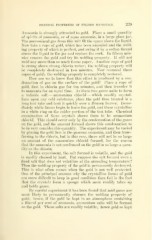Page 493 - My FlipBook
P. 493
PHYSICAL PROPERTIES OF FILLING MATERIALS. 229
Ammonia is strongly attracted to gold. Place a small quantity
of spirits of ammonia, or of atjua ammonia, in a large glass jar.
The ammouiacal gas from this will fill the space above the liquid.
Now take a rope of gold, which has been annealed and the weld-
ing property of which is perfect, and swing it by a cotton thread
above the liquid in the jar and replace the cork. In fifteen min-
utes remove the gold and try its welding property. It will not
weld any more than so much tissue paper. Another rope of gold
is swung above strong chlorin water ; the welding property will
be completely destroyed in two minutes. Now reanneal these
ropes of gold; the welding property is completely restored.
How are we to know that this effect is produced by a con-
densation of gas on the surface of the gold? Place a rope of
gold, first in chlorin gas for ten minutes, and then transfer it
to ammonia for an equal time. As these two gases unite to form
a volatile salt — ammonium chlorid — which readily crystal-
lizes upon any cold substance, place the gold thus treated in a
long test tube and heat it quickly over a Bunsen burner. Imme-
diately white fumes begin to leave the gold, and these crystallize
in a white ring on the colder portion of the test tube. Chemical
examination of these crystals shows them to be ammonium
chlorid. This should occur only by the condensation of the gases
on the gold, and the amount formed shows this condensation to
be in very considerable quantity. The experiment may be varied
by placing the gold first in the gaseous ammonia, and then trans-
ferring to the chlorin, but in this case, there will not be so large
an amount of the ammonium chlorid formed, for the reason
that the ammonia is not condensed on the gold in so large a quan-
tity as the chlorin.
In this experiment, the salt formed is volatile, and the gold
is readily cleaned by heat. But suppose the salt formed were a
fixed salt that does not volatilize at the annealing temperature!
Then the welding i^roperty of the gold is permanently destroyed.
This is what often occurs when the gold is not well protected.
One of the principal reasons why the crystalline fonns of gold
are more difficult to keep in good condition than foil is the fact
that the crystals form a sponge which more readily takes up
and holds gases.
By careful experiment it has been found that acid gases are
most likely to permanently obscure the welding property of
gold; hence, if the gold be kept in an atmosphere containing
a liberal per cent of ammonia, ammonium salts will be fonned
on the gold. These salts are readily volatile ; hence gold so kept


